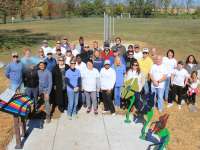Children learn about the environment and themselves by picking up information through active interaction with their surroundings (i.e. playing!). As children develop, they learn about the growing scale of their bodies and their specialized skills by using new environmental qualities and components (affordances) appropriate for their evolving abilities.
This progressive learning of affordances is supported by further exploration of the environment in an apparent endless playful cycle. The result of the co-activation of perceiving the environment and playing results in learning. Therefore, the need for diverse environments, full of novel information and rich qualities, should be considered a developmental need that goes together with children's growth and the extension of their physical capacities. Scientific research is beginning to support the idea that interaction with the environment also improves brain development.
But for this to happen from a developmental point of view, play environments should not be considered as a mere collection of play objects or physical components but sensory-rich spaces that encourage and support children's needs for stimulation. The most appropriate spaces contain all necessary ingredients to guide further exploration and discovery (i.e. play elements, people, animals,plants, and events created by the players or external sources such as wind or rain).
Rich environments support the ever-changing pattern of children's perceptions and use where play settings serve one purpose at a given time (running games on a lawn) and a totally different activity the following day (rope jumping or parachute play) on the same lawn. Multi-functional areas provide exceptional interest for children with differing learning styles and skills.
Active play throughout the space provides children with essential information about their surroundings as they discover the layout of the site, its characteristics, views, and components. They also learn about themselves, their own body scale, translocation, movement direction, interaction with other children, adults, and other living creatures. Indeed, information is actively gathered through play. Children run around objects and environmental components getting to know them (e.g. they peek over fences, hide and spy on other children from vantage points, climb up and down logs or play equipment). When engaged in self-guided exploration, children stay active, performing novel movements, challenging their own growing skills.
Outdoor play in nature is especially stimulating as nature is ever changing, highly sensory, and engaging. Children are fascinated by playing with natural unstructured objects such as twigs, flowers, rocks, and the most popular substances on Earth: soil and water!
In naturalized play areas, evergreen plants and grasses automatically add "pickable" opportunities throughout the year supporting rich sequences of play. For example, a group of girls where observed in a late autumn afternoon while they were carefully picking leaves and collecting them on top of a pail full of sand. They moved in and out of tall grasses around the periphery of the play area, harvesting the "reachable" leaves and running back and forth to the sand area. They were "cooking" a birthday party cake. Other girls joined the group activity. When the "cake" was ready, all walked in a procession-like manner to a picnic table for the "birthday party."
This active, cooperative, and harmonious group activity would not have occurred without the combined affordances of elements such as pickable grass leaves, pails, sand, picnic table, and the story line created by children's imaginations.
Children easily find and engage in these types of activities, which are compatible with their needs and imaginative processes and provide a feeling of being away in unchartered worlds. Long periods of engagement in freely chosen play activities not only supports attention restoration and creativity but the development of social skills and language, the opportunity of full immersion in the physical environment, and the unexplainable joy of being in touch with others.
"It is through play that we share our abilities, make contact with our deepest self, and unleash our potential."
- Dr. Nilda Cosco
This article was written for Words on Play®: A treatise on its value by leading play scholars™ by Nilda Cosco, Ph.D., Education Specialist, Natural Learning Initiative, College of Design, North Carolina State University Visit Dr. Cosco's bio.
Sources for this article can be found on pages 26-27 in Words on Play®.



